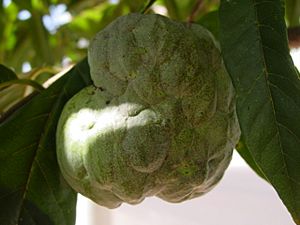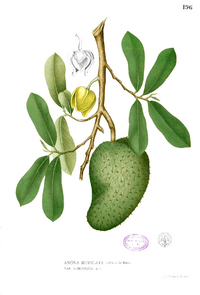Annonaceae facts for kids
Quick facts for kids Annonaceae |
|
|---|---|
 |
|
| Annona squamosa fruit | |
| Scientific classification | |
| Kingdom: | |
| (unranked): | |
| (unranked): | |
| Order: | |
| Family: |
Annonaceae
|
Annonaceae the custard-apple, or annona family, the largest family of the magnolia order. It has 129 genera and 2,220 species.
Many species are valuable for their large pulpy fruits, some are useful for their timber, and others are prized as ornamentals. The family consists of trees, shrubs, and woody climbers found mainly in the tropics, with a few species in temperate regions.
Description
The species are mostly tropical, some are mid-latitude, deciduous or evergreen trees and shrubs, with some lianas, with aromatic bark, leaves, and flowers.
Stems, stalks and leaves: Bark is fibrous and aromatic. Pith septate (fine tangential bands divided by partitions) to diaphragmed (divided by thin partitions with openings in them). Branching distichous (arranged in two rows/on one plane) or spiral. Leaves are alternate, two-ranked, simple, pinnately veined, and have leaf stalks. Stipules absent.
Flowers: Flower stalks are axillary to (on the opposite side of shoot from) leaf scars on old wood and sometimes from leaves on new shoots. The flowers are usually trimerous; borne singly or in compound inflorescences; bisexual and rarely unisexual. The receptacle might become enlarged, elevated or flat. The outer whorls are inserted below the ovaries, and have valvate (overlapping) or imbricate (nonoverlapping) segments. Usually two to four persistent sepals that are distinct or connate (fused) at the base. Six petals in two unequal whorls of three with larger outer whorls and fleshier inner whorls that might share the same nectar glands, or six to fifteen petals, with impressed veins on their inner face. Ten to twenty (or many more) stamens inserted below the ovary, spirally arranged and forming a ball or flat-topped mass with short and stout filaments and linear to oblong anthers which face outward and open longitudinally. Each flower can have from one to many pistils, distinct to connate, with stigmas distinct. Marginal placentation, each pistil bearing one locule, with one to many ovules. Style short and thick, with terminal stigma.
Fruits and seeds: Fruits are single berries or coalesce from several pistils (into aggregate fruit, syncarps). Seeds are one to many per pistil; have a fleshy and usually brightly colored cover, have ruminate endosperm (nutritive tissue surrounding the embryo) and are oily.
Images for kids
-
Asimina triloba fruit
-
Ylang-ylang (Cananga odorata) flowers.
See also
 In Spanish: Anonáceas para niños
In Spanish: Anonáceas para niños





